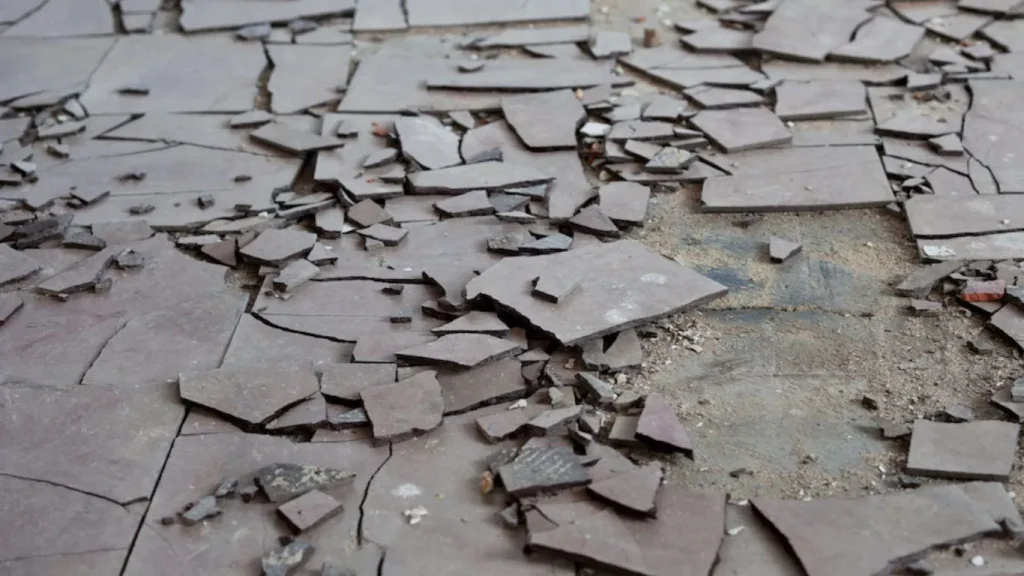Introduction
Asbestos tiles, once a popular building material, are now a cause for concern due to their health risks. Identifying these tiles is crucial for ensuring the safety of your home. Let’s delve into the details of what asbestos tiles look like and how to handle them safely.

What is Asbestos?
Asbestos is a group of naturally occurring minerals that were commonly used in construction due to their durability and resistance to heat and fire. However, asbestos fibers, when disturbed, can pose significant health risks, including lung disease and cancer.
History of Asbestos Tiles
During the mid-20th century, asbestos was widely used in construction materials, including tiles. Its popularity declined as the health risks became known, leading to stricter regulations and the eventual phasing out of asbestos in building products.
Types of Asbestos Tiles
Floor Tiles
Asbestos floor tiles were commonly used in both residential and commercial buildings. They were prized for their durability and fire resistance.
Ceiling Tiles
Asbestos ceiling tiles were popular in schools, offices, and homes. They provided a cost-effective solution for sound insulation and fireproofing.
Wall Tiles
Less common than floor and ceiling tiles, asbestos wall tiles were still used in some constructions, particularly for their fire-resistant properties.
Appearance of Asbestos Floor Tiles
Common Sizes and Shapes
Asbestos floor tiles typically come in 9×9, 12×12, and 18×18 inches sizes. They can be square or rectangular.
Typical Colors and Patterns
These tiles are often found in dark colors like black, brown, and red, though they can also be grey or white. Patterns can vary, with some tiles having a marbled or speckled appearance.
Appearance of Asbestos Ceiling Tiles
Common Sizes and Shapes
Ceiling tiles are usually larger, often measuring 12×12 inches or more. They can be square or rectangular, fitting into drop ceilings or adhered directly to the ceiling surface.
Typical Colors and Patterns
Asbestos ceiling tiles are typically white or off-white, with a smooth or slightly textured surface. Some may have perforations or a patterned design for acoustic purposes.
Appearance of Asbestos Wall Tiles
Common Sizes and Shapes
Asbestos wall tiles are less standardized in size but can be found in various rectangular dimensions.
Typical Colors and Patterns
These tiles often mimic the appearance of stone or ceramic tiles, coming in a range of colors and textures, including white, beige, and grey.
How to Identify Asbestos Tiles
Visual Inspection
While it’s possible to make an educated guess based on appearance, the only sure way to identify asbestos tiles is through professional testing. Look for tiles installed before the 1980s, as these are more likely to contain asbestos.
Professional Testing
If you suspect asbestos, contact a professional to take samples and test them in a laboratory. This is the most reliable method of identification.
Signs of Wear and Tear in Asbestos Tiles
Cracks and Breaks
Damaged tiles can release asbestos fibers into the air, posing a health risk. Look for cracks, chips, and other signs of wear.
Discoloration and Staining
Tiles that show signs of discoloration or staining may be deteriorating, increasing the risk of fiber release.
Safety Precautions When Handling Asbestos Tiles
Personal Protective Equipment (PPE)
If you must handle asbestos tiles, always wear PPE, including gloves, masks, and protective clothing, to minimize exposure.
Safe Handling and Disposal Practices
Never break, saw, or drill asbestos tiles. Keep them wet to prevent dust and contact a professional for safe disposal.
Regulations and Guidelines for Asbestos
Government Regulations
Many countries have strict regulations governing the handling and disposal of asbestos. Familiarize yourself with local laws to ensure compliance.
Safe Removal and Disposal
Always hire certified professionals for asbestos removal. Improper handling can lead to severe health risks and legal penalties.
What to Do If You Suspect Asbestos Tiles in Your Home
Immediate Steps to Take
Avoid disturbing the tiles and restrict access to the area. Do not attempt to remove the tiles yourself.
Contacting Professionals
Reach out to certified asbestos removal experts for an inspection and potential removal of the tiles.
Asbestos Tile Alternatives
Modern, Safe Alternatives
Consider replacing asbestos tiles with modern alternatives like vinyl, laminate, or ceramic tiles, which are safe and durable.
Benefits of Using Non-Asbestos Materials
Non-asbestos materials eliminate the health risks associated with asbestos and often provide better performance and aesthetics.
Renovation and Remodeling Considerations
Precautions During Renovations
If you’re planning renovations, ensure that asbestos tiles are identified and handled by professionals to prevent exposure.
Hiring Certified Professionals
Always hire certified and experienced professionals for any work involving asbestos materials. Their expertise ensures safety and compliance with regulations.
FAQs
How do I know if my tiles contain asbestos?
The only way to be certain is through professional testing. However, tiles installed before the 1980s are more likely to contain asbestos.
Can I remove asbestos tiles myself?
It is strongly recommended to hire certified professionals for asbestos removal due to the health risks involved.
Are all old tiles asbestos tiles?
Not all old tiles contain asbestos, but many installed before the 1980s do. Professional testing is the only way to confirm.
What are the health risks of asbestos exposure?
Exposure to asbestos fibers can lead to serious health issues, including lung disease, asbestosis, and various cancers.
How much does professional asbestos tile removal cost?
The cost varies based on the extent of the job and location, but professional removal typically ranges from $5 to $20 per square foot.
Conclusion
Identifying asbestos tiles is crucial for maintaining a safe home environment. By understanding their appearance and the steps to take if you suspect their presence, you can protect yourself and your family from the health risks associated with asbestos.


Congratulation!